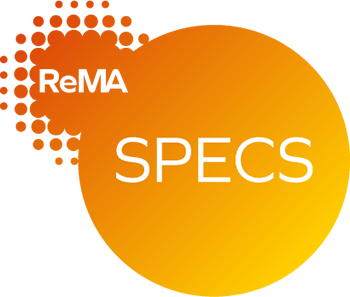Description: Any whole Polyethylene Terephthalate (PET, #1) postconsumer bottle or jar with a screw-neck top that contains the ASTM D7611 “#1, PET or PETE” resin identification code and that is clear, transparent green, or transparent light blue. All bottles should be free of contents or free flowing liquids. Closures (caps, lids, rings, and labels) may be left on bottles.
Product: Polyethylene Terephthalate Bottles
Source: Post-consumer material collected primarily from residential sources, may also include some material that has met its intended use from commercial establishments.
| PET Bale Grade | Grade A | Grade B | Grade C |
| Total PET bottle fraction by weight | 94% or above | 83 – 93% | 73 – 82% |
“PET fraction” refers to the total weight of PET bottles in a PET bale, inclusive of caps and labels when still attached to PET containers, as a percentage of the total weight of that bale.
There are 10 U.S. states with container deposit laws in place; all include a subset of PET containers. It is assumed that deposit bales will contain a high fraction of PET and that the grading scale above applies to all PET bales, including deposit. However, because the container mix, collection and aggregation process is defined through state statute, deposit bale specifications are not specifically addressed in this document.
CHECK WITH YOUR BUYER(S) as to their allowances for:
- Any other Color PET Containers (including fluorescents and opaques)
Contamination: Total contaminants should not exceed the percentages, by weight, as defined by PET bale grade chart above.
ALLOWABLE CONTAMINANTS AT LOW LEVELS: These contaminants are tolerable at low levels. The following contaminants should not exceed 2% by weight of any of the following “individual” contaminants, unless noted otherwise.
- HDPE (#2), LDPE (#4), PP (#5) rigid packaging
- Clear PET (#1) Thermoformed Plastic (e.g., clamshells, bakery trays, covers, deli containers, drink cups)
- Aluminum cans
- Loose paper or cardboard (OCC)
- Liquid residues
CONTAMINANTS NOT ALLOWED: If present, these contaminants may result in rejection.
- PVC (#3) in any form
- Chemically incompatible low temperature melting materials, including PS (#6), PETG, and PLA, as rigid or foam in any
- Any #7 plastics, including polycarbonate bottles
- Any non-packaging products
- Any bulky rigid plastics
- Any plastic bags or plastic film
- Any plastic foam
- Any Item containing degradable additives
- Containers which held hazardous materials, such as flammable, corrosive, or reactive products, pesticides, or herbicides, including motor oil bottles
- Other metal, wood, glass
- Batteries
- Bio-medical waste items (e.g., syringes, sharps, gloves, masks)
- Rocks, stones, mud, oils and grease
General: Refer to the General Information section for additional information.
Effective as of: July 14th, 2022
Terms & Conditions
Product These guidelines are designed with the potential for dealing with all recycled plastic in bale form. Initial specifications refer only to bottles. The code framework allows for generation of guidelines for all types of plastic packaging materials (including rigids and flexibles) with room for expansion to other plastic products and resins including those which are used to produce durable goods. Guidelines for those products may be added at a later date. Bale Density Bales shall be compressed to a minimum density of 10 pounds per cubic foot and a maximum density to be determined by individual contract between Buyer and Seller. Increased density may improve transportation efficiency, but over-compression may adversely affect the ability of a Buyer to separate, sort, and reprocess the material. Bale Tying Material Bale wires, ties, or straps shall be made of non-rusting or corroding material. Bale Integrity Bale integrity must be maintained through loading, shipping, handling, and storage. Distorted or broken bales are difficult to handle. They are unacceptable and may result in downgrading, rejection, or charge back. Allowable Contamination Unspecified materials must not exceed 2% of total bale weight. Bales which contain over 2% will be subjected to reduction in the contracted price of the material as well as charges for disposal of the contaminants. The reduced percentage will vary depending upon the amount and type of contamination. Quality of the baled plastic is the primary factor which determines the value. Prohibited Material Certain materials are understood to be specified as “prohibited.” Such materials will render the bale “non-specification” and may cause some customers to reject the entire shipment. These may include plastic materials which have a deleterious effect on each other when reprocessed, and materials such as agricultural chemicals, hazardous materials, flammable liquids and/or their containers, and medical waste. Liquids Plastic containers/materials should be empty and dry when baled. The bale should be free of any free-flowing liquid of any type. General Shipments should be essentially free of dirt, mud, stones, grease, glass, and paper. The plastic must not have been damaged by ultraviolet exposure. Every effort should be made to store the material above ground and under cover. A good faith effort on the part of the supplier will be made to include only rinsed bottles which have closures removed.
RELATED SPECS
Flexible PVC
Item Code: Flexible PVC
Description: Typically consists of molding, weather strip- ping, flexible tubing, p...
PP Small Rigid Plastic
Item Code: PP Small Rigid Plastic
Any polypropylene (PP) containers, packaging or products with the ASTM D7611 “#5, PP” resin iden...
Mixed Small Rigid Plastic
Item Code: Mixed Small Rigid Plastic
Small rigid plastic items that are a mix of resins and generated in a positive sort...
Mixed Bulky Rigid Plastic
Item Code: Mixed Bulky Rigid Plastic
Any large rigid polypropylene (PP) high-density polyethylene (PE) and/or Low-Density Polyethylene (L...
PET Bottles With Thermoforms
Item Code: PET Bottles With Thermoforms
Description: Any whole Polyethylene Terephthalate (PET, #1) postconsumer bottle or ...

